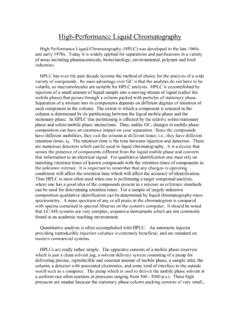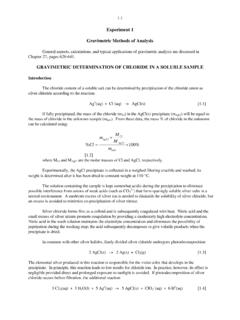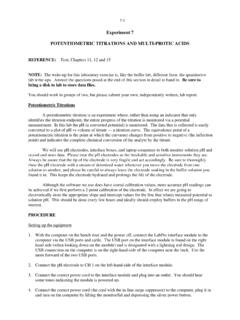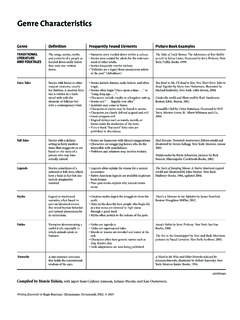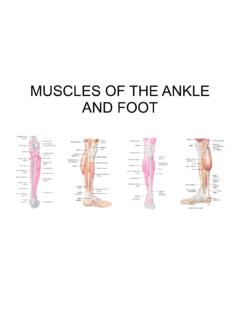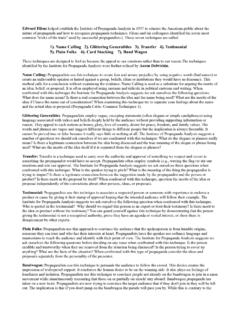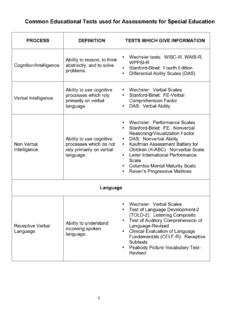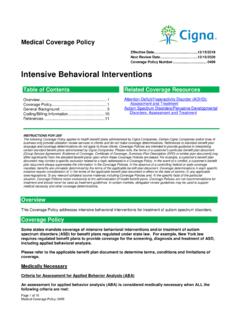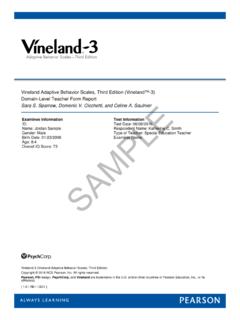Transcription of [ 151 ] Wechsler Adult Intelligence Scale—Fourth Edition
1 684[ 151 ] Wechsler Adult Intelligence scale Fourth Editionscores at high levels of adaptive functioning will have poorer precision ( , higher SEMs) than those at low The vineland II was designed to be an easily used, standardized measure of key domains of adaptive behavior Communication, Daily Living Skills, and Socialization that play a prominent role in the diagnosis of mental retar-dation and other developmental disabilities. The instrument clearly meets its goals of ease of use, clear procedures for the calculation of both raw and scaled scores, and clear and comprehensive information regarding its reliability and validity. The vineland II deserves to be considered among the best measures of adaptive behavior currently available, and the use of this instrument for mak-ing high-stakes decisions regarding individuals is recommended.
2 [ 151 ] Wechsler Adult Intelligence scale Fourth : Designed to assess the cognitive ability of adolescents and adults ; provides subtest and composite scores that represent intellectual functioning in specific cognitive domains, as well as a composite score that represents general intellectual ability. Population: Ages 16-0 to Dates: 1939-2008. Acronym: , 6: Verbal Comprehension Index, Perceptual Reasoning Index, Processing Speed Index, General Abil-ity Index, Full , 15: Block Design, Similarities, Digit Span, Matrix Reasoning, Vocabulary, Arithmetic, Symbol Search, Visual Puzzles, Information, Coding, Letter-Number Sequencing, Figure Weights, Comprehension, Cancellation, Picture : Data, 2008: $1,079 per complete test kit including Symbol Search scoring key, Coding scoring key, Cancellation scoring templates, 25 record forms, 25 response booklet #1, 25 response booklet #2, adminis-tration and scoring manual (2008, 258 pages), technical manual (2008, 218 pages), 2 stimulus books, and Block Design block : (59-100).
3 If there are significant differences between Index scores, the General Ability Index can be used to further inform interpretation; Letter-Number Sequenc-ing, Figure Weights, and Cancellation are supplemental subtests for individuals 16-0 to 69-11 : David : References: For reviews by Allen K. Hess and Bruce G. Rogers of the third Edition , see 14:415; see also T5:2860 (1422 references) and T4:2937 (1131 references); for reviews by Alan S. Kaufman and Joseph D. Matarazzo of the revised Edition , see 9:1348 (291 references); see also T3:2598 (576 references), 8:230 (351 references), and T2:529 (178 references); for reviews by Alvin G. Burstein and Howard B. Lyman of the original Edition , see 7:429 (538 references); see also 6:538 (180 references); for reviews by Nancy Bayley and Wilson H.
4 Guertin, see 5:414 (42 references).Review of the Wechsler Adult Intelligence scale Fourth Edition by GARY L. CANIVEZ, Professor of Psychology, Department of Psychology, Eastern Illinois University, Charleston, IL:DESCRIPTION. The Wechsler Adult In-telligence scale -Fourth Edition (WAIS-IV ) is the most recent version of the most frequently administered Intelligence test for older adolescents and adults, which traces its roots back to the 1939 Wechsler -Bellevue Intelligence scale ( Wechsler , 1939). Consistent with Wechsler s definition of Intelligence ( , global capacity ; Wechsler , 1939, p. 229) and all versions of his tests, the WAIS-IV seeks to measure general Intelligence through the administration of numerous subtests, each of which is an indicator and estimate of Intelligence .
5 The WAIS-IV is a major and important revision of its predecessor and clinicians should appreciate many of the In revising the WAIS-IV, several goals were noted in the technical and interpretive manual including updating theoretical foundations, increasing developmental appropriate-ness, increasing user-friendliness, enhancing clinical utility, and improving psychometric features. Object Assembly and Picture Arrangement subtests were dropped, thus reducing subtests with manipula-tive objects to one (Block Design), as were Digit Symbol-Incidental Learning and Digit Symbol-Copy. New subtests to the WAIS-IV are Visual Puzzles, Figure Weights, and Cancellation. Verbal IQ (VIQ) and Performance IQ (PIQ) are no longer provided as with the Wechsler Intelligence scale for Children Fourth Edition (WISC-IV; 16:262).
6 Ad-ministration and scoring rules were modified, easier and more difficult items were added to subtests to improve coverage and range, and discontinue rules were reduced for many subtests. Stimulus materials were enlarged as was writing space for Coding. Item bias investigations were reportedly conducted but data analyses illustrating comparisons or results were 685[ 151 ] Wechsler Adult Intelligence scale Fourth Editionnot provided. WAIS-IV content and structure are specifically related to current intellectual concep-tualizations (Carroll, 1993, 2003; Cattell & Horn, 1978; Horn, 1991) and are explicated with specific reference to the hierarchical nature of intellectual and scores. The standardization sample (N = 2,200) was obtained using stratified propor-tional sampling across variables of age, sex, race/ethnicity, education level (or parent education level for ages 16 19), and geographic region.
7 Educa-tion level is a likely proxy for SES where accurate information about income is difficult to obtain. Examination of tables in the technical and interpre-tive manual revealed reasonably close matches to the October 2005 Census across stratification variables. The technical and interpretive manual notes exclusionary criteria for standardization sample participants related to language, uncorrected sensory impairments and communication limita-tions, and upper extremity impairments limiting motor performance, as well as current medication use and physical illnesses that might affect cogni-tive test scaled scores (M = 10, SD = 3) within each of the 13 age groups were obtained using a method of inferential norming (technical and interpretive manual, p.)
8 39) where means, standard deviations, and skewness were examined from first through fourth order polynomial regressions with comparison to theoretical distributions and growth curves that produced percentiles for raw scores. Although minor irregularities were reportedly cor-rected through smoothing, the method of smoothing (statistical vs. hand/visual) was not noted. Due to reported range restriction and norming difficul-ties, certain process scores remained as raw scores, not standardized scaled scores. The Full scale IQ (FSIQ), General Ability Index (GAI), and Index scores (M = 100, SD = 15) were generated by sum-ming subtest scaled scores and normalized with composite score distributions visually smoothed to eliminate the WISC-IV, the WAIS-IV uses 10 core subtests to produce the FSIQ.
9 The Verbal Comprehension Index (VCI) and Perceptual Rea-soning Index (PRI) are each composed of 3 subtests, whereas the Working Memory Index (WMI) and Processing Speed Index (PSI) are each composed of 2 subtests. Like the WISC-IV, the General Ability Index (GAI) is calculated from the 3 verbal com-prehension and 3 perceptual reasoning subtests and may be useful in cases where the FSIQ is unduly influenced by less g-oriented subtests (WMI and PSI). The WAIS-IV FSIQ ranges from 40 160 ( 4 SD) and represents a 2/3 SD increase in IQ measurement range over the WAIS-III. This covers a wide enough range of intellectual assessment for most clinical Three types of reliability estimates for WAIS-IV scores are reported in the technical and interpretive manual: internal consistency, test-retest stability, and interscorer agreement; and strong evidence for score reliability is provided.
10 Internal consistency estimates produced by Spearman-Brown corrected split-half or coefficient alpha methods are presented for each of the 13 age groups. Internal consistency estimates across all 13 age groups ranged from .97 .98 for the FSIQ; from .87 .98 for the factor index scores (VCI, PRI, WMI, PSI); and from .71 .96 for the subtests. Standard errors of measurement based on the internal consistency estimates are also included in the technical and interpretive manual. These should be considered best-case estimates because they do not consider other major sources of error such as long-term temporal stability, administration errors, or scoring errors (Hanna, Bradley, & Holen, 1981) known to influence test scores in clinical test-retest stability was inves-tigated for 298 individuals from four age groups with retest intervals ranging from 8 82 days (mean retest interval of 22 days).
